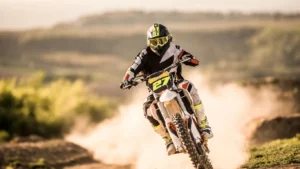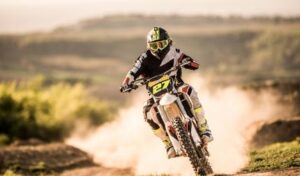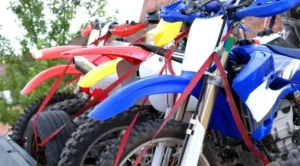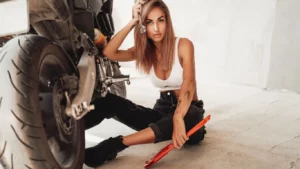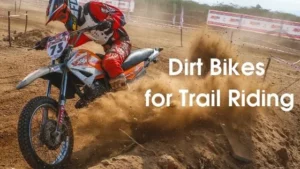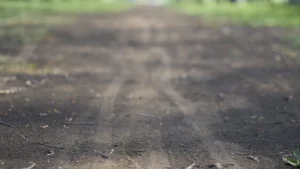Dirt biking is popular because of the thrill of the open trail, the feel of the bike under you, and navigating difficult terrain. Having the right gear is essential to fully enjoy this thrilling experience. That equipment includes the dirt bike.
With their latest technology and unblemished exteriors, new bikes are appealing, but their high prices deter many buyers. Used dirt bikes offer a cheaper way to enjoy this thrilling sport. Buying a used dirt bike isn’t as easy as picking out the latest model in a store. Thought, observation, and research are needed. A good used dirt bike checklist is essential here.
A thorough checklist ensures you get the most value from your evaluation. It helps you check the bike’s physical condition, mechanical health, legality, and more. With it, you’re less likely to miss red flags and more likely to find a bike that fits your riding style and budget.
Benefits of Buying a Used Dirt Bike
Used dirt bikes offer many advantages. First, you can save a lot. Used bikes are cheaper than new ones, making them a good option for budget-conscious riders and beginners.
Used dirt bikes are also greener. You’re recycling a bike, which helps the environment.
Finally, used bikes often have dings and scratches, so you won’t worry about adding your own as you practise.
Buying Process
Used dirt bike purchases require several steps. Understand your needs and preferences. Trail riding, motocross racing, or commuting? Use determines bike type.
Next, compare bike models, pros, cons, and prices. With this knowledge, you can search online, local dealerships, and the riding community for sellers.
Evaluation is the most important step after finding potential bikes. This includes a test ride, physical and mechanical inspection, and history and legal document verification.
Finally, if the bike meets your needs, you’ll negotiate the price, close the sale, and handle the paperwork.
Buying a used dirt bike is tedious. It’s worth it to find a bike that saves you money and performs well in off-roading.
For your safety it is necessary for you to know these 7 essential dirt bike rider protective gears.
Researching and Preparing
Determine Your Riding Needs and Preferences
Assess your riding needs and preferences before shopping. Want to try off-road biking? Do you want a bike for trail riding or competitive motocross? What terrains and frequency will you ride? These questions will determine the type of bike, its power, weight, handling, and durability.
Size and fitness also matter. For optimal control and safety, the bike’s size and weight should match your body’s.
Research Popular Dirt Bike Models
Explore popular dirt bike models after considering your preferences. Researching models will help you understand their features, performance, reliability, common issues, and rider reputation.
This research has many resources. Expert reviews, dirt bike forums, and even social media groups can offer insights. User reviews are especially helpful because they share riders’ firsthand experiences.
Assess Your Budget
Purchases depend on budget. Used dirt bikes vary in price depending on brand, model, age, condition, and other factors. Knowing your budget helps you choose and avoid overspending.
Budget for potential extras. Repairs, upgrades, maintenance, insurance, riding gear, and transport may be required.
Different Types of Dirt Bikes
Knowing the different types of dirt bikes helps you choose. The most common categories are:
- Trail Bikes: These are trail bikes. Beginners and intermediate riders will like their power-to-control ratio. They’re long-lasting, repairable, and comfortable.
- Motocross Bikes: These are designed for closed-circuit off-road racing. They lack headlights and indicators and have high-performance engines. They’re faster but harder to maintain.
- Enduro Bikes: Long-distance off-road motocross bikes. They have lights, larger fuel tanks, and are street-legal.
- Dual-Sport Bikes: Street-legal dirt bikes. They’re road- and off-road-ready. On-road commuting makes them less off-road than specialised dirt bikes.
- Adventure Bikes: These are heavy, long-distance off-road bikes. They have large fuel tanks, are comfortable, and can carry more gear, but they’re not as agile as other dirt bikes.
Knowing these types helps you match your riding style, preferences, and goals, improving your biking experience.
Locating a Used Dirt Bike
Online Marketplaces and Classified Ads
Online classifieds and marketplaces are popular ways to find used dirt bikes. Craigslist, eBay, and Cycle Trader have many listings from individual sellers and dealerships, giving you many options.
These platforms provide bike information like make, model, year, mileage, condition, and price. Most sellers upload bike pictures for a visual inspection. These websites also have search filters to narrow your options based on your preferences.
Online purchases require caution. Verify the bike’s information independently, don’t pay until you’ve seen it, and meet the seller in a public, safe place.
Local Dealerships and Motorcycle Shops
Local dealerships and motorcycle shops sell used dirt bikes. Many of these businesses buy used bikes, repair and maintain them, and sell them, offering buyers peace of mind.
Dealerships offer peace of mind with limited warranties. They can also assist with financing. Dealerships charge more than private sellers.
Networking within the Riding Community
Networking in your riding community is powerful. Attend races, join local dirt bike clubs, or join online forums and social media groups.
Fellow riders can alert you to unlisted sales and provide valuable information about the bike’s history, condition, and performance. Local sellers are less likely to sell you a lemon because they care about their reputation.
Finding a used dirt bike requires multiple avenues. Be persistent, patient, and thorough in your search. This will increase your chances of finding a bike that meets your riding needs and is a good value.
Evaluating the Seller
Seller’s Reputation and Trustworthiness
The seller’s reputation and trustworthiness are often overlooked in the buying process. Online reviews and ratings are important when buying from a dealership. Ask previous buyers about their experiences. A trustworthy dealership should have positive reviews and a good reputation.
It’s harder to evaluate a private seller. Assess their credibility based on your interactions. Do they disclose the bike’s history and condition? Are they bike-savvy? If you’re buying online, check for ratings and reviews.
Communication with the Seller
Seller communication can reveal transaction details. A trustworthy seller will respond quickly and thoroughly to your questions. They should clearly explain the bike and its flaws.
Take note of their answers. Evasive answers, reluctance to provide details, or rushing through the process may indicate the seller is hiding something.
Verifying the Bike’s Ownership and History
Buying a bike requires verifying ownership and history. Check the bike’s VIN and title with the seller. Check the bike’s title and seller’s ID.
Ask about bike ownership and history. Ask about accidents, repairs, modifications, and bike use. Tracks, trails, or streets? Did it race or ride leisurely?
Asking for Maintenance and Service Records
Service and maintenance records reveal the bike’s condition. Regular maintenance shows a responsible owner and a healthy bike. These records show the last oil change, brake service, tyre replacement or major overhaul.
A seller without any records may be suspicious. A well-maintained dirt bike can last for years, while a neglected one can cause expensive repairs and headaches.
In conclusion, the seller is as important as the bike. Buying from a reliable seller with a well-maintained bike is easier.
Physical Inspection
Checking the Overall Condition of the Bike
Start with a general bike inspection. Look for signs of neglect, damage, or unusual wear. Clean the bike. A dirt bike should have some dirt, but excessive grime, especially around the engine, can indicate poor maintenance.
Inspecting the Frame and Bodywork
It’s important to inspect the bike’s frame since it’s its foundation. Check for repairs, cracks, and bends. Frame damage can affect bike handling and be expensive to repair.
Examine the number plate and fenders. Scratches and scuffs from normal off-road use are expected, but significant damage may indicate major falls or accidents.
Assessing the Engine and Mechanical Components
Next, concentrate on the engine. Check gaskets and seals for oil leaks. Check the chain and sprockets for wear and rust.
Listen to the engine when the seller starts the bike. It should run quietly. Startup exhaust smoke is normal, but it should clear once the bike warms up. Smoke indicates engine problems.
Examining the Suspension and Steering
Check the front and rear shocks for leaks and check the suspension’s response by pressing down.
Check for steering head play or stiffness. Handlebars should turn freely.
Evaluating the Brakes and Tires
Safety depends on brakes and tyres. Check brake discs for excessive wear and deep grooves. Pressing brake levers should feel firm.
Check the tyres for uneven wear, cracks and punctures. Tires with low tread depth may need to be replaced soon, increasing costs.
Reviewing the Electrical System
Finally, check the bike’s lights and electric start. Check the bike’s battery, headlights, taillights and digital display.
The physical inspection is not to find a perfect bike—most used dirt bikes will have wear. Instead, the goal is to prevent major issues that could require costly repairs or safety concerns.
Test Riding the Bike
Importance of a Test Ride
Used dirt bike buyers must test ride. It lets you test the bike’s performance and handling and find hidden problems. Riding a bike can reveal engine issues, handling issues, and brake issues.
Preparing for the Test Ride
Prepare for the test ride. Wear a helmet, gloves, and shoes. During the ride, evaluate the bike’s power, braking, handling, and comfort.
Check the bike’s controls, especially if they’re different. Finally, ask the seller where and what kind of test ride they’ll allow.
Assessing the Bike’s Performance and Handling
During the test ride, observe the bike’s behaviour. Smooth power delivery? The bike shifts smoothly, right? Does it brake and accelerate well? Do the clutch and throttle work well?
Evaluate the bike’s handling. It should be stable at low and high speeds and respond predictably to your inputs. To test the suspension, ride over some bumps.
Check the engine and suspension for unusual sounds. Strange noises may indicate mechanical issues.
The test ride’s purpose is to identify any obvious issues and make sure the bike fits your riding style and ability. Return the bike in its original condition out of respect for the seller.
In conclusion, a test ride is essential to your decision-making process, and skipping it could lead to regrets. Take time to test ride and evaluate the bike before making a decision.
Document Verification and Legal Considerations
Reviewing the Title and Registration
After checking the bike’s condition and performance, focus on the legalities. Examine the bike’s title and registration first. The bike’s title is legal proof. Check the seller’s name and VIN against the bike’s.
Check the registration’s validity. Up-to-date registration makes transferring the title to your name easier, depending on the jurisdiction.
Checking for Outstanding Loans or Liens
Due to a loan, a lender or bank has a lien on a dirt bike. If you buy a bike with a lien, the lender may repossess it or make you pay the debt.
Ask the seller about bike loans and liens. Run the bike’s VIN through a national database like the US National Motor Vehicle Title Information System. Before buying, make sure any liens are paid.
Understanding Local Laws and Regulations
Before buying, research local dirt bike laws. These can include where you can ride, whether the bike must be registered or insured, and whether you need a special licence or permit.
If the bike isn’t street-legal, you’ll need to know what modifications are needed to comply with local laws.
Remember, buying a used dirt bike involves legalities as well as the bike itself. These steps prevent future issues.
Warranty Options for Used Dirt Bikes
Used dirt bikes’ warranties vary by seller and age. Dealerships may offer a limited warranty on parts or issues. Understanding a warranty’s coverage and duration is crucial.
Private sellers sell bikes “as is” without warranties. To avoid unexpected repair costs, the buyer must inspect the bike before buying.
Availability of Spare Parts and Accessories
Check the dirt bike’s spare parts and accessories. Some models have abundant, cheap parts, while others have scarce, expensive ones. This availability can greatly affect ownership costs and experience.
Consider adding bike accessories or modifications. Are they accessible and within your budget?
Insurance Coverage for Used Dirt Bikes
Used dirt bikes require insurance. Where and how you use the bike affects insurance requirements.
You may not need insurance if you ride on private property or designated off-road trails. You’ll need liability insurance if you ride the bike on public roads. Even if it’s not required, insurance can cover theft or damage.
Get quotes and coverage options from local insurers. Know how your age, riding experience, and bike’s make, model, and year affect your insurance cost.
These factors may seem minor compared to the bike and seller, but they can significantly affect your used dirt bike ownership experience and costs. Thus, before buying, consider these factors.
Making the Purchase
Finalizing the Price and Payment Method
After checking the bike’s condition and legality, make the purchase. This begins with a seller-accepted price. This price should reflect the bike’s condition, the market value of similar models, and your inspection and test ride negotiation points.
Discuss payment after settling on a price. Cash is usually easiest, but if the price is high, the seller may prefer a bank transfer or cashier’s cheque. Make sure you and the seller understand the payment method.
Drafting a Bill of Sale
Create a bill of sale. This document lists the bike’s make, model, VIN, buyer, seller, sale price, and date. It protects both parties by documenting the transaction.
The buyer and seller should sign the bill of sale and keep a copy for their records. Find sample bills of sale online, but make sure they comply with local laws.
Completing the Necessary Paperwork
Transferring the title and registering the bike in your name requires paperwork. Contact your local DMV or equivalent agency for details.
Sales tax may be required. Before buying, consider this.
While buying a used dirt bike is exciting, you must take the time to complete these final steps. They will give you legal protection and peace of mind as you ride your new bike.
Maintenance and Upkeep
Establishing a Maintenance Schedule
Establish a maintenance schedule after buying a used dirt bike. Regular bike maintenance ensures safety, longevity, and peak performance. If the bike’s manual isn’t available, look online for maintenance intervals. Oil changes, air filters, brake checks, chain and sprocket inspections and tyre checks are typical maintenance tasks.
Routine Inspections and Cleaning
Check your dirt bike for damage regularly and check tyres for cuts and pressure. Check the chain and sprockets for excessive wear. Verify the brakes’ operation.
Clean your bike regularly. Dirt can hide problems and accelerate component wear. Clean body and undercarriage with mild detergent and soft brush. Check the bike for damage after cleaning.
Replacing Worn-out Parts and Components
Despite maintenance, parts will wear out and need replacement. Regular inspections will reveal worn parts before they fail. Brake pads, tyres, chains, and sprockets should be given special attention.
Replacing parts can be costly, but it’s an opportunity to upgrade. Many aftermarket parts outperform the originals.
In conclusion, your used dirt bike needs regular maintenance to last for years. Respect its limits and it will give you many hours of riding pleasure.
Frequently Asked Questions (FAQs)
1. What should I look for when buying a used dirt bike?
When buying a used dirt bike, check for excessive wear and tear, repairs and good starting and running. Check the engine, brakes, tyres, and suspension. Review the bike’s documents and look for loans or liens.
2. How can I verify the bike’s ownership history?
Title and registration documents show the bike’s history. Match the seller’s ID. To check for liens and verify the bike’s history, run the VIN through a national database like the US National Motor Vehicle Title Information System.
3. Is it better to buy from a dealership or a private seller?
Both have advantages and disadvantages. Dealerships may offer financing, warranties, and reputation, but their prices are higher. Private sellers offer lower prices, but you’ll need to be thorough in your inspections and legal checks. Your choice may depend on budget, comfort, and bike preferences.
4. Can I negotiate the price of a used dirt bike?
Used dirt bikes are often negotiated. During your inspection and test ride, look for repairs or excessive wear that could be negotiated. Research the bike’s market value. Negotiate with this knowledge.
5. What should I do if the bike needs repairs after purchase?
If you bought the bike “as is” from a private seller, you’ll likely have to pay for repairs. Check your warranty if you bought from a dealership. Always budget for repairs when buying a used bike.
6. Are there any specific brands or models to avoid?
You should avoid models with persistent mechanical issues or hard-to-find parts, but this depends on your preferences and experiences. To learn about model reliability and owner satisfaction, read reviews.
Conclusion
This guide covers used dirt bike purchases. Researching and understanding your riding needs, finding and evaluating potential bikes and sellers, conducting detailed inspections and test rides, understanding the documentation and legalities, negotiating the price, and buying can take months.
This process requires inspection and research. Each step—checking the seller’s reputation, inspecting the bike, test-riding it, and verifying documentation—is crucial. Research reduces post-purchase issues.
Finally, some buying tips: Know your needs and preferences, research models and market prices, carefully evaluate the seller and bike, conduct thorough inspections and test rides, check all legal aspects and documentation, negotiate wisely, and consider post-purchase factors like insurance, spare parts availability, and maintenance.
Finally, find a bike that will bring you joy, excitement, and off-road freedom. Take your time and trust your instincts—you’ll be riding your new dirt bike soon!
Happy riding!

